 W
WThe 3rd Polish Infantry Brigade was a Polish infantry brigade which served during World War II. Together with the 10th Armoured Cavalry Brigade they formed part of the 1st Polish Armoured Division and was created from Polish soldiers who had already escaped from Poland to France, and after the fall of France made their way to Great Britain. Their wartime headquarters were in Biggar High School, South Lanarkshire
 W
WThe action at Barfleur was part of the battle of Barfleur-La Hougue during the War of the Grand Alliance. A French fleet under Anne Hilarion de Tourville was seeking to cover an invasion of England by a French army to restore James II to the throne, but was intercepted by an Anglo-Dutch fleet under Edward Russell, 1st Earl of Orford on 19 May Old Style 1692.
 W
WThe Action at Cherbourg was fought on 21 and 22 May Old Style 1692 as part of the aftermath of the Battle of Barfleur which had just been fought on 19 May 1692.
 W
WThe Action at La Hogue occurred during the pursuit by the English of the French fleet after the Battle of Barfleur on 19 May Old Style, 1692, during the Nine Years' War. The pursuing English fleet, under the command of Admiral of the Fleet Edward Russell, 1st Earl of Orford, destroyed a number of French ships that had been beached near the port of Saint-Vaast-la-Hougue.
 W
WOperation Aquatint was the codename for a failed raid by British Commandos on the coast of occupied France during the Second World War. The raid was undertaken in September 1942 on part of what later became Omaha Beach by No. 62 Commando, also known as the Small Scale Raiding Force.
 W
WThe Battle of Arques occurred on 15–29 September 1589 between the French royal forces of King Henry IV of France and troops of the Catholic League commanded by Charles of Lorraine, Duke of Mayenne, during the eighth and final war (1585-1598) of the French Wars of Religion. It was a victory for Henry IV.
 W
WOperation Atlantic was a Canadian offensive during the Battle of Normandy in the Second World War. The offensive, launched in conjunction with Operation Goodwood by the Second Army, was part of operations to seize the French city of Caen and vicinity from German forces. It was initially successful, with gains made on the flanks of the Orne River near Saint-André-sur-Orne but an attack by the 4th and 6th Canadian Infantry Brigades of the 2nd Canadian Infantry Division, against strongly defended German positions on Verrières Ridge to the south was a costly failure.
 W
WThe Azeville battery was a World War II German artillery battery constructed close to the French village of Azeville in the Manche department in the Normandy region in northwestern France. It formed a part of Germany's Atlantic Wall coastal fortifications and was involved in the Normandy landings and shelled the US landing beach UTAH for three days after D-Day, 6 June 1944. The battery was heavily bombed on 9 June 1944 and fell to the Americans the same day. The site is owned by the local council and one of the battery's gun casemates now houses a museum.
 W
WThe Battles of Barfleur and La Hougue took place during the Nine Years' War, between 19 May Old Style and 4 June Old Style 1692. The first was fought near Barfleur on 19 May Old Style, with later actions occurring between 20 May Old Style and 4 June Old Style at Cherbourg and Saint-Vaast-la-Hougue in Normandy, France.
 W
WThe Battle of Ivry was fought on 14 March 1590, during the French Wars of Religion. The battle was a decisive victory for Henry IV of France, leading Huguenot and English forces against the Catholic League by the Duc de Mayenne and Spanish forces under the Count of Egmont. Henry's forces were victorious and he went on to lay siege to Paris.
 W
WThe Battle of Bloody Gulch took place around the Manoir de Donville or Hill 30, approximately 1 mile (1.6 km) southwest of Carentan in Normandy, France, on June 13, 1944.
 W
WThe Battle for Caen is the name given to fighting between the British Second Army and the German Panzergruppe West in the Second World War for control of the city of Caen and vicinity, during the larger Battle of Normandy. The battles followed Operation Neptune, the Allied landings on the French coast on 6 June 1944 (D-Day). Caen is about 9 mi (14 km) inland from the Calvados coast astride the Orne River and Caen Canal, at the junction of several roads and railways. The communication links made it an important operational objective for both sides. Caen and the area to the south is flatter and more open than the bocage country in western Normandy; Allied air force commanders wanted the area captured quickly to base more aircraft in France.
 W
WThe Battle of Caen on 26 July 1346 was the assault on the French-held town by elements of an invading English army under King Edward III as a part of the Hundred Years' War. The English army numbered 12,000–15,000, and part of it, nominally commanded by the Earls of Warwick and Northampton, prematurely attacked the town. Caen was garrisoned by 1,000–1,500 soldiers and an unknown, but large, number of armed townsmen, commanded by Raoul, the Count of Eu, the Grand Constable of France. The town was captured in the first assault; more than 5,000 of the ordinary soldiers and townspeople were killed and a few nobles were taken prisoner. The town was then sacked for five days.
 W
WThe Café Gondrée is a small coffeehouse in the French community of Bénouville. The cafe is located on the west bank of the Caen Canal, at the northwest end of the Bénouville Bridge, now commonly referred to as the Pegasus Bridge. The building was the site of first combat during the D-Day invasion, and is best known for its role commemorating those events.
 W
WThe Siege of Caudebec was a military event that took place between 24 April to 21 May 1592 as part of the French Wars of Religion and the Anglo-Spanish War (1585–1604). The Spanish and the French Catholic League forces of Duke of Parma had captured the town of Caudebec on the Seine, where they soon found themselves trapped by the reinforced Royalist Protestant army led by Henry of Navarre consisting of French, English, and Dutch troops. Seeing that Henry's force had now surrounded him, Parma seeing that defeat was inevitable, pulled his 15,000 men across the river in a single night to escape and retreat to the south.
 W
WThe Battle of Cocherel was a battle fought on 16 May 1364 between the forces of Charles V of France and the forces of Charles II of Navarre, over the succession to the dukedom of Burgundy. The result was a French victory.
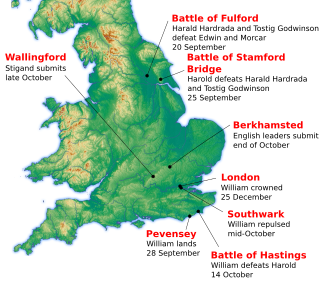 W
WThe Norman conquest of England was the 11th-century invasion and occupation of England by an army made up of Norman, Bretons, Flemish and French knights, all led by the Duke of Normandy later styled William the Conqueror.
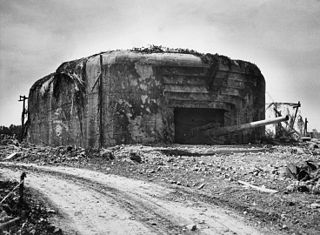 W
WThe Crisbecq Battery was a German World War II artillery battery constructed by the Todt Organization near the French village of Saint-Marcouf in the department of Manche in the north-east of Cotentin peninsula in Normandy. It formed a part of Nazi Germany's Atlantic Wall coastal fortifications. The main armament were three Czech 21 cm Kanone 39 canons, two of which housed in heavily fortified casemates up to 10 feet thick of concrete. The battery, with a range of 27–33 kilometers, could cover the beaches between Saint-Vaast-la-Hougue and Pointe du Hoc.
 W
WOperation Deadstick was the codename for an operation by airborne forces of the British Army that took place in the early hours of 6 June 1944 as part of the Normandy landings of the Second World War. The objective was to capture intact two road bridges in Normandy across the River Orne and the Caen Canal, providing the only exit eastwards for British forces from their landing on Sword Beach. Intelligence reports said both bridges were heavily defended by the Germans and wired for demolition. Once captured, the bridges had to be held against any counter-attack, until the assault force was relieved by commandos and other infantry advancing from the landing beach.
 W
WWorld War II for Écouché culminated with several days of street fighting by Free French forces under General Philippe Leclerc. This engagement was part of the encirclement of the remaining German army in the final engagement of the Battle of Normandy. This final carnage of the German army was later called the Falaise Pocket, the Argentan-Falaise Pocket or Couloir de la Mort as the local French named it.
 W
WThe Battle of Formigny, fought on 15 April 1450, was a major battle of the Hundred Years' War between the kingdom of England and the kingdom of France. The destruction of England's last army in Normandy in the battle and the decisive French victory paved the way for the capture of the remaining English strongholds in Normandy.
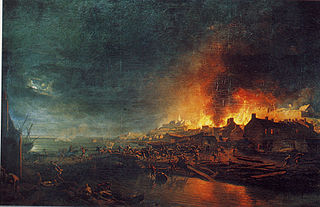 W
WThe Siege of Granville occurred at Granville, Manche on 14 November 1793. It faced 5,000 Republicans besieged by Vendéen forces during the Virée de Galerne. The battle ended with a Republican victory.
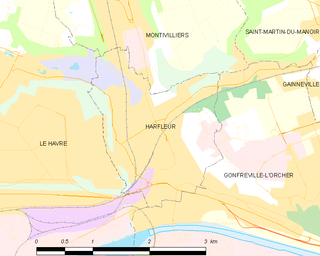 W
WThe Siege of Harfleur was conducted by the English army of King Henry V in Normandy, France, during the Hundred Years' War. The defenders of Harfleur surrendered to the English on terms and were treated as prisoners of war. The English army was considerably reduced by casualties and an outbreak of dysentery during the siege but marched towards Calais, less a garrison left behind at the port. The English were intercepted en route and fought the Battle of Agincourt, inflicting a huge defeat on the French.
 W
WHervé Riel was a French fisherman of the 17th century, from Le Croisic in Brittany. His claim to fame is that while serving with the French Navy he was instrumental in saving the French fleet following the battle of Barfleur in 1692. He is the subject of a heroic poem by Robert Browning, but little else is known of him or his life.
 W
WThe Hillman Fortress was a German bunker complex and command post built during the Second World War and located near Colleville-Montgomery in Normandy, France. The bunker complex, designated as Hill 61 and codenamed Hillman by the British, was attacked on 6 June 1944 by the Suffolk Regiment and the fortress finally surrendered the following morning. The delay in taking the bunker complex has been cited as a reason for the Allies not completing their major D-Day objective of taking Caen.
 W
WThe Battle of the Îles Saint-Marcouf was an engagement fought off the Îles Saint-Marcouf near the Cotentin peninsula on the Normandy coast of France in May 1798 during the French Revolutionary Wars. Dislodging a British garrison on the islands was the main objective for French forces. The garrison allowed the islands to serve as a resupply base for Royal Navy ships patrolling northern French waters. Apart from expelling the British, the French sought to test new equipment and tactics, which had allegedly been developed with an intention of invading Britain.
 W
WJuno or Juno Beach was one of five beaches of the Allied invasion of German-occupied France in the Normandy landings on 6 June 1944 during the Second World War. The beach spanned from Courseulles, a village just east of the British beach Gold, to Saint-Aubin-sur-Mer, and just west of the British beach Sword. Taking Juno was the responsibility of the Canadian Army, with sea transport, mine sweeping, and a naval bombardment force provided by the Royal Canadian Navy and the British Royal Navy as well as elements from the Free French, Norwegian, and other Allied navies. The objectives of the 3rd Canadian Infantry Division on D-Day were to cut the Caen-Bayeux road, seize the Carpiquet airport west of Caen, and form a link between the two British beaches on either flank.
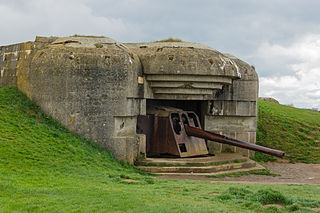 W
WThe Longues-sur-Mer battery was a World War II German artillery battery constructed near the French village of Longues-sur-Mer in Normandy. The battery was sited on a 60 m (200 ft) cliff overlooking the sea and formed a part of Germany's Atlantic Wall coastal fortifications. It was located between the Allied landing beaches of Gold and Omaha and shelled both beaches on D-Day. The battery was captured on June 7 and played no further part in the Normandy campaign.
 W
WThe Maisy Battery is a group of World War II artillery batteries constructed by the German Wehrmacht near the French village of Grandcamp-Maisy in Normandy. It formed a part of Germany's Atlantic Wall coastal fortifications and was the principal position of defence for that area. It was responsible for the defense of the sector between the Longues-sur-Mer and the St Marcouf (Crisbecq) batteries. It could target the sectors around both Omaha Beach and Utah Beach, two of the five landing sites for the Allied invasion of Normandy in June 1944.
 W
WThe Merville Gun Battery is a decommissioned coastal fortification in Normandy, France, which was built as part of the Germans' Atlantic Wall to defend continental Europe from Allied invasion. It was a particularly heavily fortified position and one of the first places to be attacked by Allied forces during the Normandy Landings commonly known as D-Day. A British force under the command of Terence Otway succeeded in capturing this position, suffering heavy casualties.
 W
WThe Battle of Le Mesnil-Patry during the Second World War, was the last attack by an armoured battle group conducted by Canadian troops in Normandy in June 1944. The Queen's Own Rifles of Canada of the 8th Canadian Infantry Brigade of the 3rd Canadian Division, supported by the 6th Armoured Regiment of the 2nd Canadian Armoured Brigade attacked the village of Le Mesnil-Patry in Normandy, to advance southwards towards the higher ground of Hill 107 to the west of Cheux. The attack was intended to support a larger operation by the 50th (Northumbrian) Infantry Division and the 7th Armoured Division to capture the city of Caen and to advance in the centre of the bridgehead next to the First US Army. The battle was a German defensive success but the greater German objective of defeating the invasion by a counter-offensive also failed.
 W
WThe Mont Canisy battery was a World War II German artillery battery constructed close to the French village of Benerville-sur-Mer in the Calvados department in the Lower Normandy region. Located on the highest ground in Normandy, the vantage point overlooks the Côte Fleurie. The bunker complex was constructed between 1941 and 1944 to protect the River Seine estuary and the port of Le Havre. It was the largest artillery bunker complex between Cherbourg and Le Havre. The battery is 8 km (5.0 mi) east of the Houlgate battery.
 W
WThe Normandy American Cemetery and Memorial is a World War II cemetery and memorial in Colleville-sur-Mer, Normandy, France, that honors American troops who died in Europe during World War II. It is located on the site of the former temporary battlefield cemetery of Saint Laurent, covers 172.5 acres and contains 9,388 burials.
 W
WThe Normandy Campaigns were wars in Normandy from 1202 to 1204. The Kingdom of England fought the Kingdom of France as well as fighting off rebellions from nobles. Philip II of France conquered the Anglo-Angevin territories in Normandy, resulting in the Siege of Château Gaillard. The Normandy Campaigns ended in a victory for France when the Anglo-Angevin territory was greatly diminished.
 W
WOmaha, commonly known as Omaha Beach, was the code name for one of the five sectors of the Allied invasion of German-occupied France in the Normandy landings on June 6, 1944, during World War II. "Omaha" refers to an 8-kilometer (5 mi) section of the coast of Normandy, France, facing the English Channel, from east of Sainte-Honorine-des-Pertes to west of Vierville-sur-Mer on the right bank of the Douve River estuary. Landings here were necessary to link the British landings to the east at Gold with the American landing to the west at Utah, thus providing a continuous lodgement on the Normandy coast of the Bay of the Seine. Taking Omaha was to be the responsibility of United States Army troops, with sea transport, mine sweeping, and a naval bombardment force provided predominantly by the United States Navy and Coast Guard, with contributions from the British, Canadian, and Free French navies.
 W
WOrglandes War Cemetery is a German World War II cemetery in Normandy, France. It is located on the northern edge of the village of Orglandes, about 30 km (19 mi) south east of Cherbourg and 7 km (4.3 mi) west of Sainte-Mère-Église on the Cotentin Peninsula. The burials come from summer 1944, immediately following D-Day and the Battle of Normandy. It is the second smallest of the six German war cemeteries in Normandy with a little over 10,000 burials. The cemetery is maintained and managed by the voluntary German War Graves Commission.
 W
WPegasus Bridge, originally called the Bénouville Bridge after the neighbouring village, is a road crossing over the Caen Canal, between Caen and Ouistreham in Normandy. The original bridge, built in 1934, is now a war memorial and is the centrepiece of the Memorial Pegasus museum at nearby Ranville. It was replaced in 1994 by a modern design which, like the old one, is a bascule bridge.
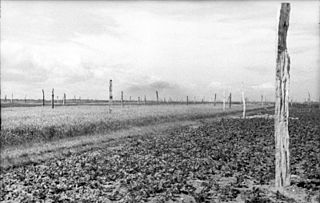 W
WRommel's asparagus were 4-to-5-metre logs which the Axis placed in the fields and meadows of Normandy to cause damage to the expected invasion of Allied military gliders and paratroopers. Also known in German as Holzpfähle, the wooden defenses were placed in early 1944 in coastal areas of France and the Netherlands against airlanding infantry. Rommelspargel took their name from Field Marshal Erwin Rommel, who ordered their design and usage; Rommel himself called the defensive concept Luftlandehindernis.
 W
WThe Siege of Rouen was a key military engagement of the first French Wars of Religion. After having been seized by those opposing the crown on 16 April, the siege, beginning on 28 May and culminating on 26 October brought the important city of Rouen back into the crowns control. The fall of Rouen would set the stage for the main battle of the war at Dreux several months later.
 W
WThe siege of Château Gaillard was a part of Philip II's campaign to conquer the king of England's continental properties. The French king besieged Château Gaillard, a Norman fortress, for six months. The Anglo-Normans were beaten in the battle and the consequence was the fall of Normandy.
 W
WThe Siege of Dieppe took place during the Hundred Years War. English forces led by John Talbot, Earl of Shrewsbury besieged and failed to capture the French-held port of Dieppe in Normandy.
 W
WThe Siege of Rouen was a major event in the Hundred Years' War, where English forces loyal to Henry V captured Rouen, the capital of Normandy, from the Norman French.
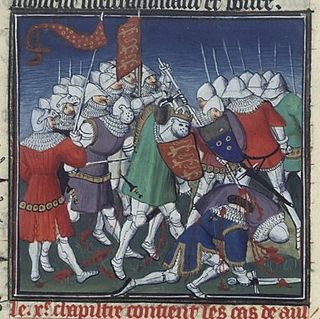 W
WThe Battle of Tinchebray took place on 28 September 1106, in Tinchebray, Normandy, between an invading force led by King Henry I of England, and the Norman army of his elder brother Robert Curthose, the Duke of Normandy. Henry's knights won a decisive victory: they captured Robert, and Henry imprisoned him in England and then in Wales until Robert's death in 1134.
 W
WThe Battle of Verneuil was a strategically important battle of the Hundred Years' War, fought on 17 August 1424 near Verneuil in Normandy and a significant English victory. It was a particularly bloody battle, described by the English as a second Agincourt.
 W
WThe Battle of Villers-Bocage took place during the Second World War on 13 June 1944, one week after the Normandy Landings, which had begun the Western Allies' conquest of German-occupied France. The battle was the result of a British attempt to improve their position by exploiting a gap in the German defences west of the city of Caen. After one day of fighting in and around the small town of Villers-Bocage and a second day defending a position outside the town, the British force retreated.
 W
W W
W W
W